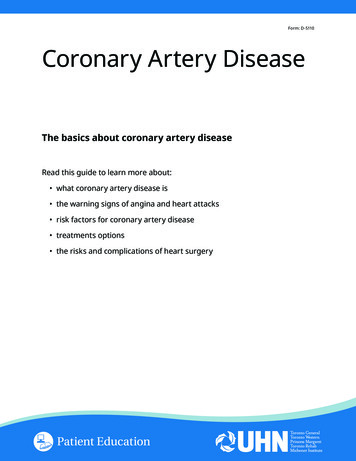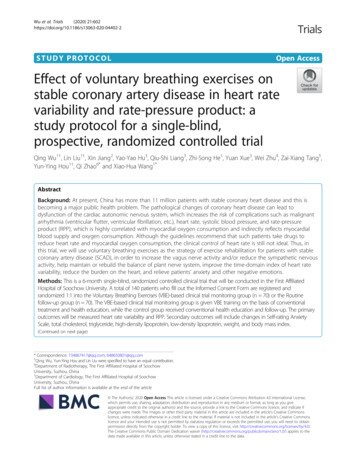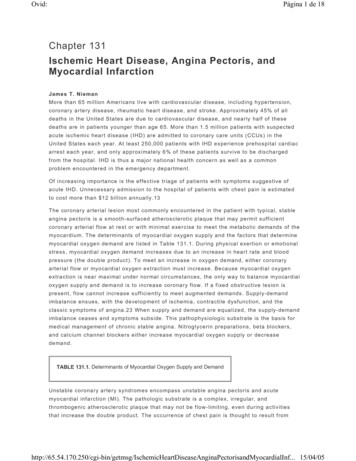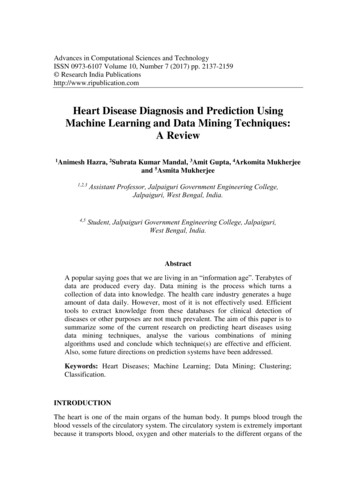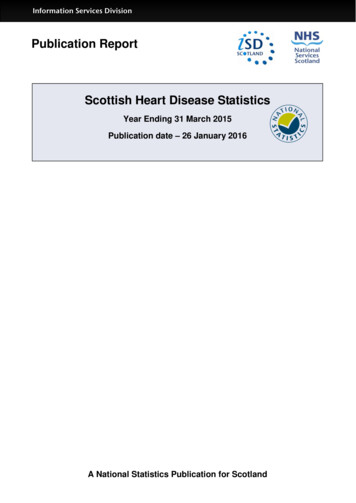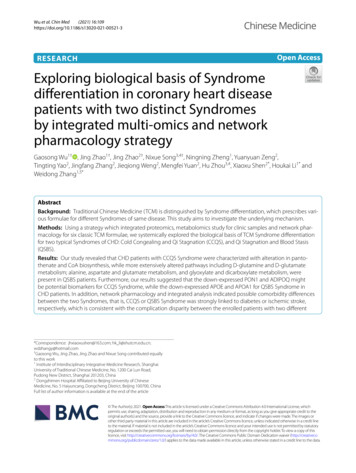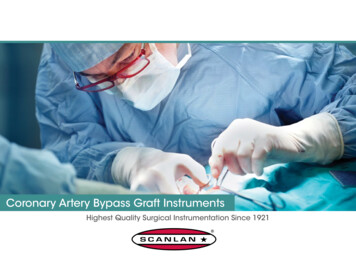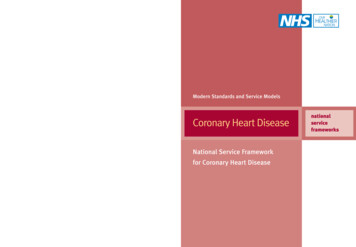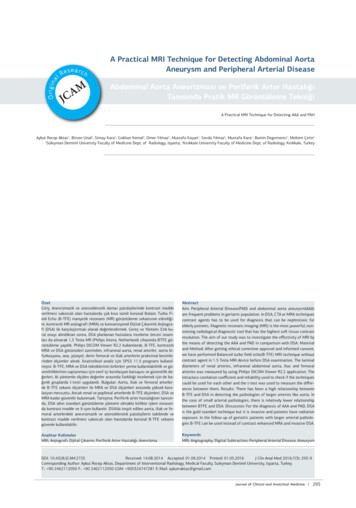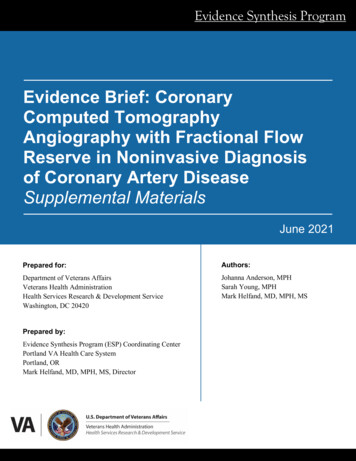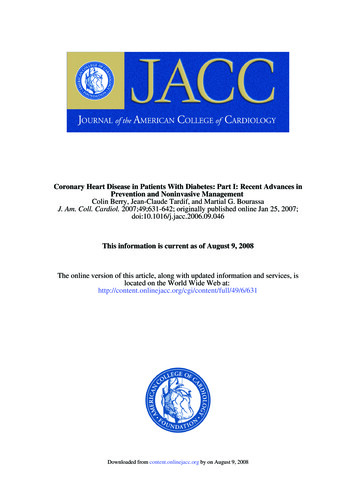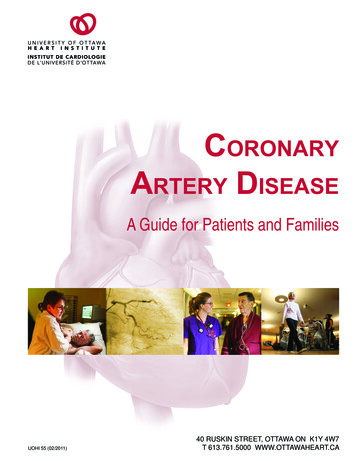
Transcription
CoronaryArtery DiseaseA Guide for Patients and FamiliesUOHI 55 (02/2011)40 RUSKIN STREET, OTTAWA ON K1Y 4W7T 613.761.5000 WWW.OTTAWAHEART.CA
PREPARING FOR DISCHARGEBefore you leave, please make sure you have: Attended the cardiology discharge preparation class. Please ask your nurse fordetails. Reviewed this Guide with your family/significant other. “Discharge Prescription/Notes” Letter: This is completed by your doctor and hasinformation related to your diagnosis and treatment as well as all medicationsand follow up plans. The white copy is yours to keep; the yellow copy is to begiven to your family physician. (We will mail this copy to your family physician.)The end of the white copy is to be removed and given to your pharmacist. The GAP Tool: This is completed by your nurse. It outlines your medications, riskfactors, and follow-up appointments. Information or an appointment with the Cardiac Rehabilitation Program. If you have concerns regarding your discharge or financial problems please letyour doctor or nurse know as soon as possible. We can ensure that you meetwith a Social Worker who may be able to assist you with these difficulties. “Vial of Life” Package. This is a plastic resealable bag containing a largemedication vial, magnet for your refrigerator and directions on how to participatein this program.IMPORTANTNursing Coordinator: 613-761-4708Please call the Nursing Coordinator if you have symptoms or concernsthroughout your recovery period. The Nursing Coordinator can be reachedanytime of the day or night
PLEASE BRING THIS BOOK WITH YOU TO THEHEART INSTITUTEPatient NamePlease complete the following information:Contact Person(relative, friend)Family DoctorPharmacyCardiologistOther (Specify)NamePhone Number(Home)Phone Number(Cell)NamePhone NumberNamePhone NumberNamePhone NumberNamePhone Number
Table of ContentsABOUT HEART DISEASEHeart Anatomy . 1Heart Disease . 2Tests . 4Risk Factors . 11The Healing Process. 19HEART HEALTHY LIVINGHeart Healthy Nutrition. 20Physical Activity . 29Stress, Depression and Anxiety . 36Sexual Health and Heart Disease . 42RECOVERYGoing Home – A New Beginning . 45For Family and Caregivers . 48Medications . 50Participate in a Cardiac Rehabilitation Program . 57APPENDICESAppendix 1 – Where to Go for More Information . 62Appendix 2 – Rate Your Weight . 66
2011 University of Ottawa Heart InstituteThis Patient Guide and its contents are the property of the University of Ottawa Heart Institute (UOHI). They may not be modified, sectioned, copied,reproduced or republished without prior explicit permission from UOHI. For more information about customizing this guide for the particular needs ofyour institution, please contact the Department of Communications at 613-798-5555 x19058 or communications@ottawaheart.ca.The Heart Institute logo and swirl are trademarks of the University of Ottawa Heart Institute.All other trademarks are the property of their respective owners.1
Heart AnatomyThe Heart Is a PumpThe heart is a muscle that pumps bloodaround the body through a series ofpipes. These pipes are called arteries.The left side of the heart receives fresh,oxygen-rich blood from the lungs andthen pumps it out a large artery calledthe aorta that branches into smallerarteries that go to all parts of the body.The various parts of the body then takethe oxygen out of the blood and the nowstale, oxygen-poor blood is returned tothe right side of the heart through pipescalled veins. The right side of the heartpumps this stale blood to the lungswhere it picks up more oxygen and thecycle begins again.The Coronary ArteriesThe heart muscle, like every other part of the body, needs its own oxygen-rich bloodsupply. Arteries branch off the aorta and spread over the outside surface of the heart.The Right Coronary Artery (RCA) supplies the bottom part of the heart. The short LeftMain (LM) artery branches into the Left Anterior Descending (LAD) artery that suppliesthe front of the heart and the Circumflex (Cx) artery that supplies the back of the heart.1
Heart DiseaseHeart disease, also known as cardiovascular disease, is a general term for a variety ofconditions that affect the heart and blood vessels. It is a chronic disease that can lead toserious events including heart attack and death. Heart disease is one of the leadingcauses of death in Canada and worldwide. The most common form of heart disease iscoronary artery disease (CAD) caused by atherosclerosis.AtherosclerosisOver time, plaque builds up on the inside wall of arteries. Plaque is made of severalsubstances including cholesterol. This build up is called atherosclerosis or hardening ofthe arteries. It can start at an early age and is caused by a combination of genetic andlifestyle factors that are called risk factors. Atherosclerosis can cause a narrowing in thearteries to various parts of the body such that blood flow is slowed or blocked. Poorblood flow to the brain can cause a stroke. Poor blood flow to the arms or legs is calledperipheral artery disease (PAD). Poor blood flow to the heart is called coronary arterydisease (CAD) and can cause angina or a heart attack.AnginaPlaque build up in the coronary arteries to the heart causes poor blood flow and theheart may not receive all the oxygen that it needs. This usually occurs when the hearthas to work harder such as while walking, climbing stairs, or feeling worried or upset.When the heart isn’t getting enough oxygen, it can cause pain or pressure in the middleof the chest that may spread to the arms, neck, or jaw. Sometimes there may beshortness of breath, sweating, or nausea. This pain is called angina and usually goesaway within 2 to 20 minutes by resting or taking a medication called nitroglycerin. Itdoes not cause any heart damage.Unstable AnginaSometimes, the plaque in the artery can crack open suddenly. The blood forms a clotover the cracked plaque but this clot causes a sudden narrowing of the artery. Thechest pain or angina may now occur more frequently, with less exercise, or last longerthan usual. This change in the pattern of angina is called unstable angina.Heart AttackIf the heart is starving for blood and not getting enough oxygen for more than 20minutes, then a part of the heart muscle dies causing some permanent damage. This iscalled a heart attack or myocardial infarction (MI). Heart attacks are confirmed with2
blood tests and a test that shows the electrical activity of the heart called anelectrocardiogram (ECG).Some heart attacks involve only a small area of the heart and can be managed withstandard medical treatment in hospital. Some heart attacks involve a larger area of theheart and have a specific pattern on ECG. These heart attacks are called ST-elevationmyocardial infarctions (STEMI) and require immediate treatment with clot dissolvingdrugs or opening up the artery with balloon angioplasty and stents.Chest PainAnginaUnstableAnginaHeart AttackWhile RestingRareSometimesCommonGoes Away with Rest or NitroglycerinYesYesSometimesLasts More than 20 MinutesNoNoYesCauses Permanent Heart DamageNoNoYesHeart DamageSome heart attacks cause very little damage to the heart muscle and the heart can stillpump strongly. Some heart attacks are larger and the muscle damage causes a weakheart. There are several heart tests that measure the strength of the heart such as anechocardiogram (an ultrasound of the heart that looks at the pumping strength of theheart and how the heart valves work), nuclear scans such as a MUGA scan, or aventriculogram which is commonly done during an angiogram.3
TestsThere are several tests that can check if plaques are blocking the coronary arteries tothe heart. These include: treadmill test (fast walking on a treadmill while attached to anECG machine), nuclear scan such as SPECT or PET scan, stress echocardiogram, CTangiography scan, or angiogram.AngiogramWith this test, a small tube or catheter is inserted into an artery in the groin or wrist andguided to the heart. A dye is injected through this tube and into the coronary arteries sothat they can be seen by an X-ray. This shows if there is plaque blocking the arteriesand whether the blockages should be treated just with medications or if there is alsoneed for an angioplasty or coronary artery bypass grafting (CABG) surgery. Sometimesdye is injected into the pumping chamber of the heart to check how strong the heart isand if there was any damage to the heart muscle. This is called a ventriculogram. Thecatheter is then removed.Insertion Sites for Angiogram4
Angioplasty and StentsSometimes blockages in the coronary arteries can be fixed with angioplasty. A smalltube or catheter is inserted into an artery in the groin or wrist and guided to the heart aswith the angiogram. In this procedure, a small balloon at the end of the catheter can beinflated for a short period of time to push the plaque back against the wall of the arteryso that blood can flow better.In many patients, a small metal mesh tube or stent, is placed over the balloon. Whenthe balloon is deflated and removed, this stent stays permanently where the blockagewas and lowers the risk of this area narrowing again. Some stents are metal alone (baremetal stents). Others have a medication coating on them (drug eluting stents).A. The balloon catheter and collapsed stent are inserted into the narrowed artery.B. The balloon is inflated to expand the stent. C. The balloon catheter is removed leavingthe stent in place.Advantages of AngioplastyOver 90% of angioplasties are successful immediately. Blood flow through the arteryreturns to normal or near normal. Some people may not have complete relief, but theirsymptoms are improved, allowing them to be more active and comfortable.There is no incision as this is not surgery and you are not put to sleep (generalanesthesia). Most people are up and walking on the same day. Some people go homethe same day, but some patients are required to stay overnight and go home thefollowing morning.5
Disadvantages of AngioplastyAn artery may become narrow again after angioplasty. This is called restenosis. If theartery narrows enough, you may feel angina again. The use of stents has reduced therestenosis rate. Restenosis is usually treated with a second angioplasty, butoccasionally bypass surgery is needed or medical therapy is used.Risks of Angiogram and AngioplastyAngiogram and angioplasty (with or without stent implantation) are common procedures.Your physician has carefully considered your clinical condition and believes that thebenefits of the procedure outweigh the risks. However, since these procedures areinvasive there are risks associated with them.Common risks include: Bleeding at the catheter insertion site or other organs due to blood thinningmedication (anticoagulants)Less common but potentially more serious risks include: Heart attackStrokeUnknown dye allergyKidney problems, including kidney failure requiring dialysisEmergency heart surgeryDeathOther rare and unpredictable complicationsIn 1% to 2% of angioplasty cases, the artery collapses or is damaged by the wire orballoon. A stent can often fix this, but sometimes patients need emergency coronaryartery bypass surgery. At the Heart Institute, our operating rooms are close by if apatient needs surgery.Discuss the risks and benefits of your procedure with your doctor.6
Coronary Artery Bypass GraftingSometimes the blocked arteries cannot be fixed with angioplasty/stents and may requirecoronary artery bypass grafting (CABG) which is surgery that requires opening thechest. Arteries inside the chest, an artery from the wrist, or pieces of vein from the legare used to go around the blockages in the coronary arteries. This surgery requires arecovery time of five to seven days in hospital and one to two months at home.What to Expect During an AngiogramBefore Your ProcedureAfter a brief discussion with the nurse you will be taken into the Catheterization Lab andasked to lie on a special X-ray table. The temperature in the room will be very cold. Youwill be attached to a heart monitor.As this is a teaching hospital there may be other physicians, nurses and labtechnologists involved in your procedure. All staff will be wearing gowns, masks andspecial aprons.Your groin/wrist will be washed with a cold solution and sterile sheets will be placedover you. It is important that you neither move nor touch the top of the sheets once theyare in place. You may be asked to lie with your arms above your head for a period oftime. A nurse will be available to assist you.During Your ProcedureYou will be given medication to help you relax, but you will be awake during theprocedure so that you can follow instructions from the doctor and nurses. The doctor willadminister freezing to your groin/wrist. A small catheter will be threaded through a bloodvessel up to the heart. A contrast dye will be injected through this catheter to highlightthe coronary arteries. Most patients experience a sensation of body warmth as the dyeis injected or the urge to empty their bladder.X-ray pictures will be taken throughout the procedure. The X-ray machine will moveover you very close to your body.During the procedure, you may be asked to take a deep breath and hold it for a fewseconds, or to cough. It is not unusual to experience some chest pain. Inform the nurseif you experience any discomfort or have concerns.The time for the procedure in the lab is usually between 30 to 90 minutes. If yourcondition is complex, your procedure will be longer.Due to unforeseen circumstances there may be a lengthy wait in the lab waiting area oryou may be returned to your room until the lab is available.7
After Your ProcedureYou will leave the Catheterization Lab on a stretcher, and one of the following willhappen: After an angiogram: The catheter will be removed and a special clamp ormanual pressure will be applied. A sand bag will then be placed over your grointo continue pressure on the puncture site. After an angioplasty: You will be transferred to a unit which specializes incatheter (sheath) removal if a groin insertion was used, or back to the sendingunit if the wrist was used.The nurse will frequently check your pulse, blood pressure, pulses in your feet or wrist,and the puncture site.Following a groin insertion: If the doctor used your groin (femoral artery), you must remain on bed rest for upto 6 hours after the procedure. It is important to keep your head on the pillow and your affected leg straight. Youwill be reminded frequently to do these two things to avoid bleeding from thepuncture site. If you experience back discomfort, you can be repositioned with the help of anurse, keeping your affected leg straight. The head of your bed may be elevatedslightly. During this time you may sleep, read or rest. You will be given a snack.Following a wrist insertion: If the doctor used your arm (radial artery) you will have a clamp applied to yourarm in the lab to prevent bleeding. You will be on bed rest for approximately one hour after the procedure. During this time you may sleep, read or rest. You will be given a snack.It is important to keep your arm on the pillow and refrain from twisting your wrist.You may move your fingers. Your nurse will be available to assist you while theclamp is in place.Ask your nurse for assistance as soon as you need to empty your bladder. It is importantnot to sit up. The nurse will assist you in getting up once your bed rest is complete. You willbe encouraged to walk around during the hour before discharge.8
ActivityFollowing a groin (femoral) insertion: Limit the amount of stair climbing as much as possible. Try to climb the stairsonly once on the day of your procedure. Do not lift anything heavy—greater than 10 lbs (4.5 kg) —for 48 hours.Apply pressure to your groin if you have to sneeze or cough hard for 48 hours.The easiest way to apply pressure is to make a fist and place it firmly on thegroin area over the band-aid.Following a wrist (radial) insertion: Do not lift anything greater than 10 lbs (4.5 kg) with the affected arm for 48 hoursafter the procedure. Avoid vigorous wrist movements of the affected arm. You may elevate your arm on a pillow to help prevent swelling.Dressing You may remove the clear dressing or band-aid the day after the procedure, andreplace it with a new band-aid. A small amount of dried blood on the old dressing and puncture site is normal. Do not take a tub bath or cleanse the arterial puncture site for 48 hours after yourtest. You may re-apply a dry band-aid for a few more days in order to keep the skinclean and reduce the risk of trauma or infection. The band-aid may be removed72 hours after the procedure. Try to avoid wearing tight or restrictive clothing over the puncture site.You may take a shower the day after your test, but do not allow the dressing tostay wet.9
Puncture SiteExamine the site every day and notify your nurse or physician if any of these problemsdevelop: An expanding lump or persistent area of redness and warmthYellow drainage from the wound siteWorsening numbness in the leg, hand, wrist, or armSevere discomfort at the puncture siteMild discomfort at the procedure site or forearm is normal and may be treated withTylenol or application of a warm, dry towel.BleedingIf any bleeding occurs while in hospital, please ring for your nurse immediately. If asmall amount of bleeding occurs at the puncture site at home: For a wrist site, sit down immediately and apply firm pressure to your wrist withyour fingers for ten minutes. For a groin site, lie down and apply pressure to your groin using a fist placedfirmly on the groin area over the band-aid.If the bleeding stops, remain quiet and keep your procedure leg/wrist immobile for twohours.If recurrent bleeding occurs, notify your physician as soon as possible. If you are unsure as to what action you should take phone 613-761-4708 andask to speak with the Cardiology Nursing Co-coordinatorIf the bleeding does not stop or if there is a large amount of bleeding: CALL 911 IMMEDIATELY. DO NOT DRIVE YOURSELF TO THE HOSPITAL.Lie down and hold firm pressure on the site until help arrives.10
Risk FactorsAt the University of Ottawa Heart Institute, you have received the best available cardiaccare to treat and manage your heart condition, but your heart disease is not cured.Heart disease is a chronic health condition and, like any health problem, it can bringuncertainty and changes into your every day life.You can respond to these changes in different ways. Research tells us that learningabout your risk factors, taking charge of your heart health, and staying involved in yourhealth and health care will help you to continue to do the things that you wish to do.The following three-step plan will help you learn to take care of your heart and preserveyour health:Step 1Step 2Step 3Get to know your own risk factors and plan how to managethem. Use the risk factor profile on page 13 to help you toidentify your risk factors and think about how you might setsome health goals.Participate in a Cardiac Rehabilitation Program. Work withspecialists in nutrition, physical activity, stressmanagement, return-to-work counselling, and other socialand emotional services to develop a plan that is tailored toyour specific needs.Learn how to live and work with heart disease. Use theinformation here to help you get through the normal boutsof anxiety and emotional ups and downs so that you canrenew your sense of well being.11
Causes of Heart DiseaseCoronary artery disease is caused by a combination of genetic and lifestyle factors.These are called risk factors.The following risk factors are important to be aware of but are not considered to becontrollable: Your age Your gender Men over the age of 55 are at higher risk of heart diseaseAfter menopause, a woman’s risk of heart disease gradually becomes thesame as a man’sYour heredity As you get older, your risk of heart disease increasesYour risk of heart disease is increased if close family members—a parentbrother or sister—developed heart disease before age 55 or, in the caseof female relatives, before menopause.Your ethnicity First nations people and people of African or Asian descent are at higherrisk of developing heart diseaseThe risk factors that you can control are: SmokingExcess body weight, especially around your waistHigh blood pressure (hypertension)Abnormal blood cholesterol levelsLack of regular exerciseDiabetesExcessive stress levelsDepressionThese are referred to as modifiable risk factors.12
Modifiable Risk Factors for Heart DiseaseRisk FactorTarget GoalsInformation PageSmokingSmoke Freep. 14OverweightIdeal range: BMI of 18.5 – 25If your BMI is above 25, aim for a 5 – 10%reduction of your total body weight.Heart Healthy Nutrition: p. 20WaistCircumferenceWeight Management: p. 25Waist:Women: Below 35 in (88cm)Men: Below 40 in (102 cm)High BloodPressureHigh CholesterolPhysical InactivityIf you haveDiabetesLess than 140/90 in your doctor's office and Heart Healthy Nutrition: p. 20less than 135/85 at homeBlood Pressure: p. 15If you have diabetes or kidney disease: lessthan 130/80 in your doctor's office and less Safe Medications: p. 54than 125/75 at homeLDL-C: below 2.0 mmol/LHeart Healthy Nutrition: p. 20TC /HDL-C Ratio: less than 4.0Triglycerides: below 1.7mmol/LCholesterol: p. 15Aim for 30 to 60 minutes of moderateexercise (example: brisk walking) on mostdays of the weekHealthy Physical Activity:p. 29Fasting blood sugar:between 4.0 and 7.0 mmol/LHeart Healthy Nutrition: p. 20Diabetes: p. 17HgA1C: below 7%StressedDepressedManage stressp. 36Manage depressionp. 3813
SmokingHow Smoking Affects Your HeartThe nicotine in smoke causes the arteries of the heart to narrow. The carbon monoxidereleased from cigarettes causes damage to the walls of the arteries encouraging thebuild up of fat on those walls.Smoking also: Raises your LDL (lousy) cholesterolLowers your HDL (healthy) cholesterolSpeeds up your heart rateIncreases your blood pressureSmoking after a heart attack or angioplasty increases the chances of a second heartattack and/or restenosis (re-blocking) of the coronary arteries.If You Smoke, Quit! Quitting smoking is the single most important thing you can do to positively affectyour heart health. The benefits of quitting occur within 20 minutes of your last cigarette and at oneyear your risk of a heart attack is reduced by 50%.The Heart Institute’s Quit Smoking Program is available to all smokers who areinterested in quitting. We use proven techniques and individualized counselling to helppeople quit. To register for the Quit Smoking Program, please call 613-761-5464. Thereare other options for quitting smoking in our region. It is up to you to decide which optionis best.Keep in mind this one important tip: most people find that the more support they getwhile trying to quit, the better.More Information about Quitting SmokingWeb Sites Canadian Cancer Society Smokers Helpline: www.smokershelpline.ca14
High Blood PressureHow High Blood Pressure Affects Your HeartHigh blood pressure makes your heart work harder, damages your blood vessels, andcan also cause greater plaque build up. All these factors eventually lead to heartdamage. Controlling your blood pressure can reduce the progression of your heartdisease and may reduce your risk of having a stroke.To control your blood pressure: Follow your Heart Health Nutrition PlanAchieve and maintain a healthy body weightBe active every day and follow your physical activity planPractice stress management techniques that work for youTake your medications as prescribedBecome smoke freeMore Information about High Blood PressureWeb Sites Blood Pressure Canada: www.hypertension.ca/bpc/ Healthy Ontario: www.healthyontario.comHigh Blood CholesterolHow Cholesterol Affects Your HeartCholesterol is a fat-like substance that is produced mostly in your liver, although someof the cholesterol in your blood comes from the foods you eat.The most important types of cholesterol in your blood are: Low density lipoprotein cholesterol or LDLHigh density lipoprotein cholesterol or HDL15
L is for “Lousy”: LDL cholesterol carries fats to your body organs to be stored away for future use. High levels of LDL can damage artery walls.It causes a build-up of cholesterol (plaque) on the walls of the arteries in yourheart.Eating heart healthy and maintaining a healthy weight can lower your LDL.H is for “Healthy”: HDL cholesterol is good because it carries excess fats away from your bodyorgans for elimination. The more HDL you have in your blood, the better protected you are against thebuild-up of plaque in your arteries. Regular exercise and quitting smoking can help increase HDL.How You Can Improve Your Cholesterol Be aware of your cholesterol levelsFollow your Heart Health Nutrition PlanAchieve a healthy body weight (see page 66)If you smoke, stop (see page 14)Be active every day and follow your Physical Activity Plan (see page 29)Attend a nutrition workshop (see page 27)Take your cholesterol medications as prescribed by your doctorMore Information about CholesterolBooks Coping with Cholesterol, Elizabeth Mansfield (2006)Web Sites Healthy Ontario: www.healthyontario.com16
If You Have DiabetesHow Diabetes Affects Your HeartDiabetes or an elevated blood sugar level can lead to changes in the circulatory system.These changes may cause damage to your heart.Keeping Your Blood Sugar Levels Healthy Take your medications as prescribed Monitor and keep track of your blood sugarsLearn about managing diabetes by attending a diabetes education program (seeMore Information below)Target: blood sugar before meals between 4.0 and 7.0 mmol/LTarget: blood sugar two hours after meals between 5.0 and 10.0 mmol/LFollow the Heart Healthy Nutrition PlanBe active every day and follow your Physical Activity Plan (see page 29)Achieve and maintain a healthy body weight (see page 66)Visit to your family doctor or diabetes specialist regularlyAdditional Meal Planning Tips Eat regular meals. Aim to eat every 4 to 6 hours. Include a healthy snack if mealsare more than 4 to 6 hours apart. Eat breakfast. If you are thirsty, drink water or sugar free drinks. Drinking regular soft drinks,sweetened drinks or fruit juices will raise your blood sugar level. If you have acondition requiring fluid restriction, follow your personalized recommendations. Have portion sizes that will help you reach or maintain a healthy body weight.Limit sugars and sweets such as sugar, regular soft drinks, fruit drinks, desserts,candies, jam, syrup and honey.17
More Information about DiabetesIt’s natural to have questions about what food to eat. A registered dietitian can help personalizeyour meal plan. If you have diabetes and are taking insulin, speak with your family doctor. Youmay need to see an endocrinologist (a doctor specializing in diabetes).Community Diabetes Education Program of Ottawa For adults with type 2 diabetes who are controlled with diet, pills or just starting insulin;no major health problems related to their diabetes Teaching is also available for people with pre-diabetes Group and individual sessions on healthy eating, getting active, testing blood glucose,stress and emotions, delaying or preventing complications and foot care In English, French and other languages Web site: www.diabeteseducation.ca To register, call 613-233-6655 or fax a doctor’s referral to 613-233-6713Diabetes Education Programs (Outside Ottawa) To locate a diabetes education program near you, see Diabetes Ontario atwww.diabetesontario.org or contact Canadian Diabetes Association at 1-800-BANTING(226-8464) or at info@diabetes.caBooks The Essential Diabetes Book, Mayo Clinic (2009)Web Sites Canadian Diabetes Association: www.diabetes.ca, 1-800-BANTING (226-8464)18
The Healing ProcessEvery year, thousands of Canadianssurvive a heart attack, go back towork and enjoy a normal life. Yourheart is healing and with eachpassing day you'll get stronger andmore active. With a heart attack, aportion of your heart muscle hasbeen damaged. This is sometimes adifficult concept to understandbecause you cannot see the damagethat has been done to your heart.How Long It Will TakeYour Heart to HealThe post heart attack healing period varies, often depending on the size of your heartattack and can last anywhere from one to three months. If you are not sure how big yourheart attack was, please ask your doctor before you are discharged.The first week is important because your heart is starting to heal. It is important to havea calm and relaxing environment for the heart to rest and recover.From the second week on
Heart Disease Heart disease, also known as cardiovascular disease, is a general term for a variety of conditions that affect the heart and blood vessels. It is a chronic disease that can lead to serious events including heart attack and death. Heart disease is one of the leading causes of death in Canada and worldwide.
